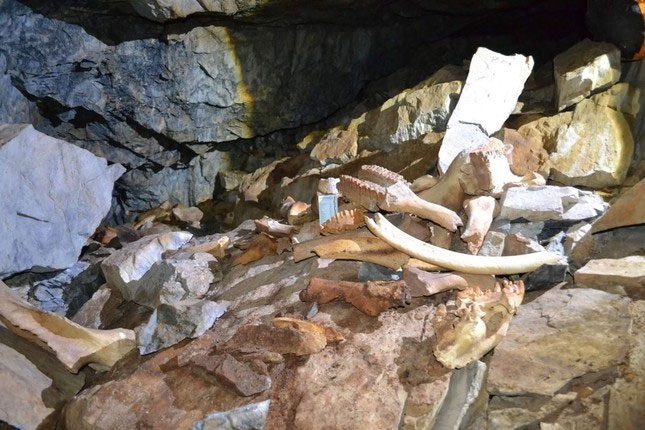The local residents of Siberia have uncovered an astonishing prehistoric cave that paleontologists believe to be the largest cave of ancient hyenas ever found in Asia. This cave contains a treasure trove of well-preserved animal bones dating back approximately 42,000 years.
Paleontologists have discovered bones from both predators and prey from the Pleistocene era (2.6 million to 11,700 years ago), including brown bears, foxes, wolves, woolly mammoths, rhinoceroses, yaks, deer, antelopes, aurochs, horses, rodents, birds, fish, and frogs.

The bones found inside the cave in Siberia are 42,000 years old. (Photo: VS Sobolev Institute of Geology and Mineralogy).
Residents of Khakassia, a republic in southern Siberia, discovered the cave five years ago, according to a statement translated from the VS Sobolev Institute of Geology and Mineralogy. However, due to the remoteness of the area, paleontologists were unable to fully explore and examine the remains until June of this year.
They collected approximately 400 kg of bones, including two complete skulls of cave hyenas. Paleontologists suspect that hyenas lived in the cave because the bones show gnawing marks consistent with hyena teeth.
“Additionally, we found a series of bones in anatomical order. For example, in the rhinoceros, the ulna and radius bones were found together,” stated Dmitry Gimranov, a senior researcher at the Ural Branch of the Russian Academy of Sciences. “This suggests that hyenas dragged parts of the rhinoceros carcass into the cave.”
The researchers also found bones of young hyenas, which tend to be poorly preserved due to their fragility, indicating that they were nurtured within the cave. “We even found the skull of a juvenile hyena, along with several lower jaws and milk teeth,” said Gimranov.
The well-preserved bones due to Siberia’s frigid weather
Siberia is rich with remains of Pleistocene animals. The bones and sometimes skin, flesh, and even blood of these animals are often not much different from the year they died. This is largely thanks to the frigid weather that has preserved the remains.
The bone fragments have been sent to Yekaterinburg for further analysis. Dmitry Malikov, a senior researcher at the Geology and Mineralogy Institute of the Siberian Branch of the Russian Academy of Sciences, stated: “We will also obtain crucial information from coprolites, the fossilized dung of animals for further study.”



















































